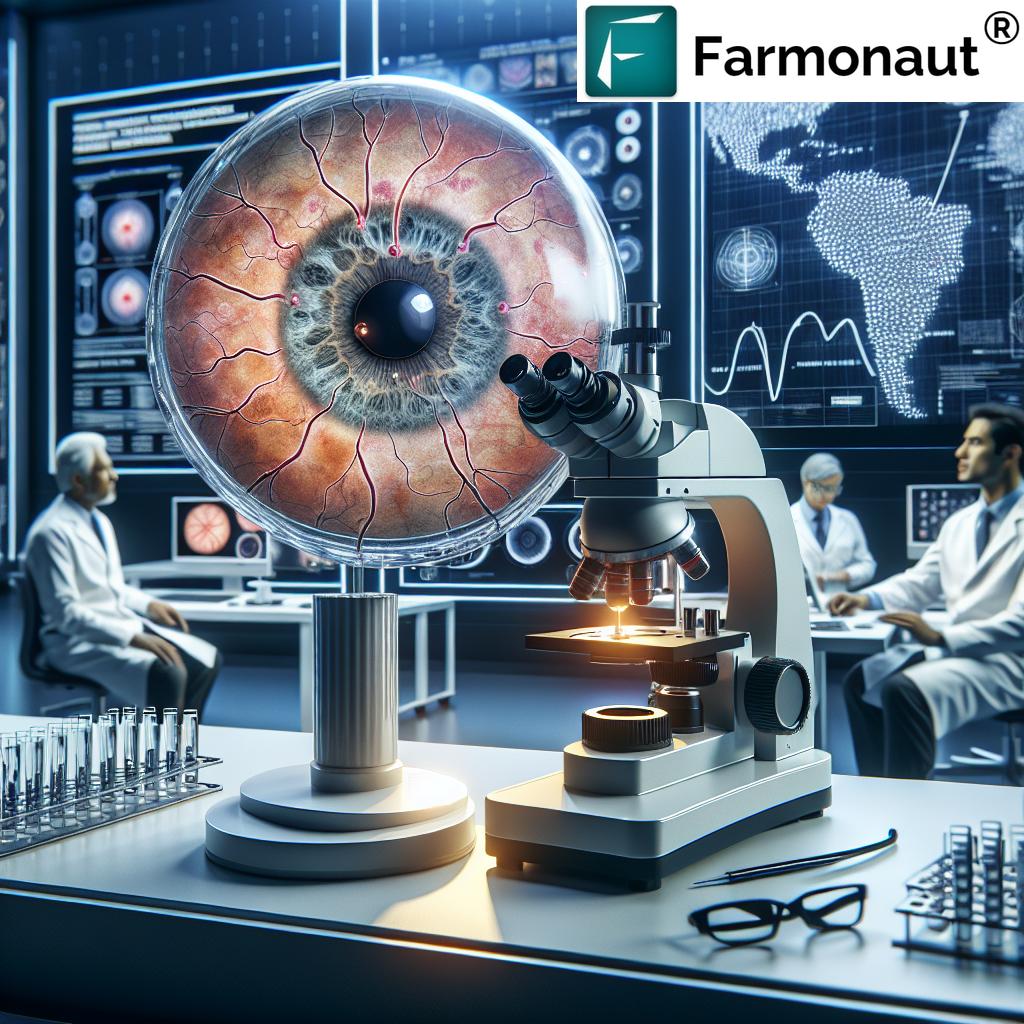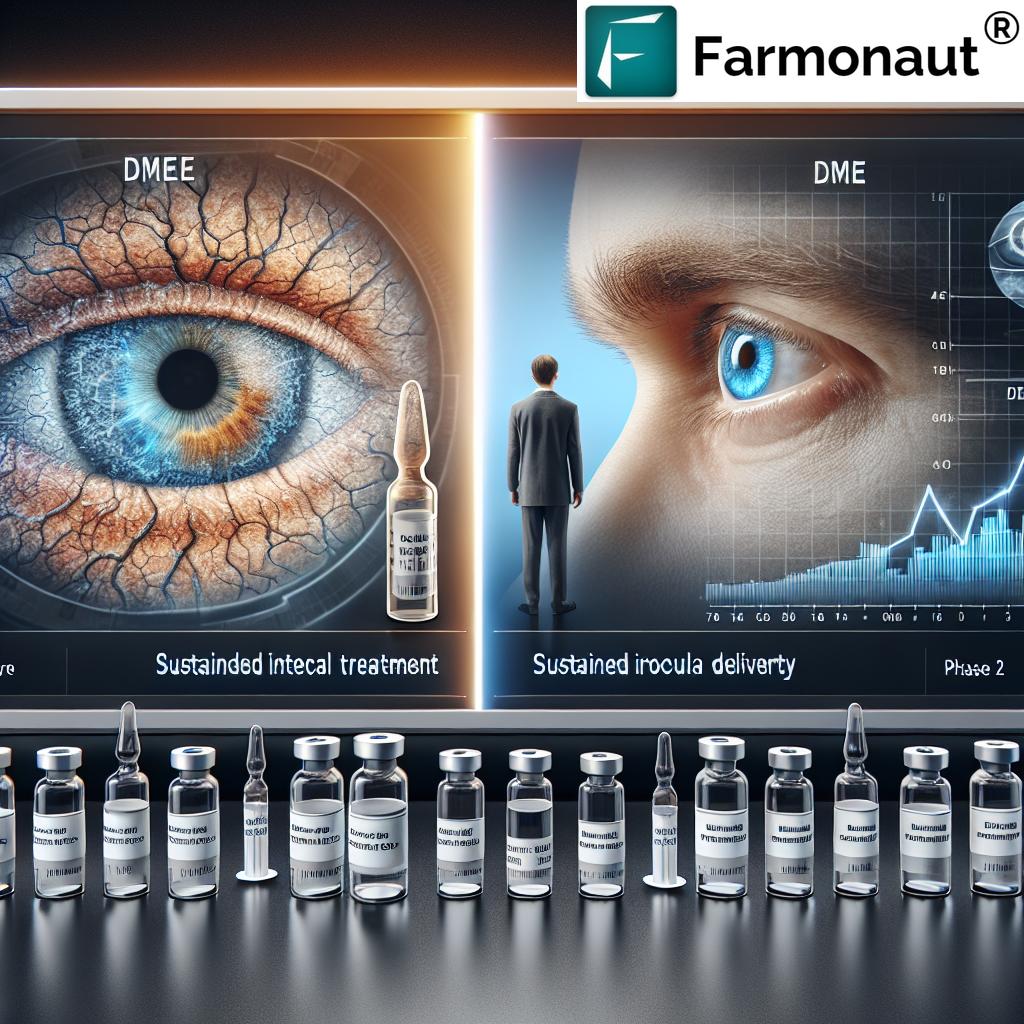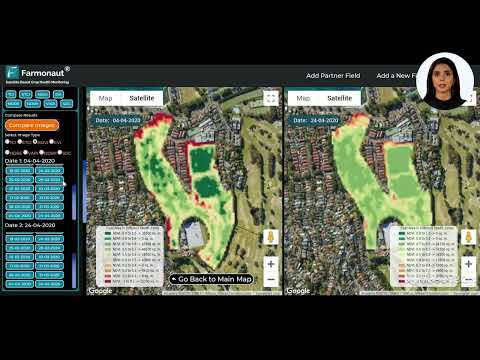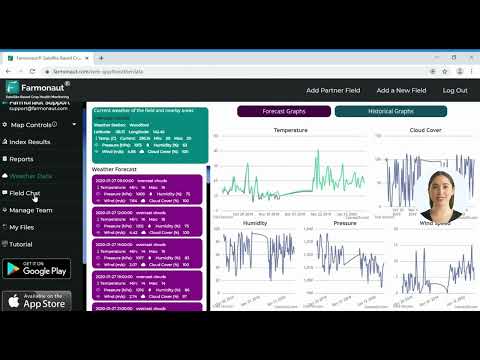Breakthrough in Retinal Disease Treatment: Innovative Drug Delivery Technology Advances Clinical Trials
“Phase 3 global trials for wet AMD and Phase 2 trials for DME are underway, targeting two major retinal diseases.”
In the rapidly evolving landscape of ophthalmology, we are witnessing groundbreaking advancements in retinal disease treatments and eye drug delivery technology. As leaders in the pharmaceutical industry, we are excited to share the latest developments in innovative eye therapeutics that promise to revolutionize the way we approach serious eye conditions. Our commitment to developing and commercializing cutting-edge therapeutics for patients with serious retinal diseases has led to significant progress in macular degeneration therapy and diabetic macular edema treatment.
At the forefront of these advancements is our proprietary sustained intraocular drug delivery technology, which has shown remarkable potential in clinical trials for eye diseases. This breakthrough approach is not only enhancing the efficacy of treatments but also improving patient compliance and quality of life. As we delve into the details of our recent progress, we’ll explore how these innovations are shaping the future of ophthalmology and offering new hope for those suffering from vision-threatening conditions.
The Promise of Sustained Intraocular Drug Delivery
Our lead product candidate, leveraging the innovative Durasert E™ technology, represents a significant leap forward in VEGF-mediated retinal disease treatments. This sustained intraocular drug delivery system is designed to provide long-lasting therapeutic effects while minimizing the need for frequent injections, a common drawback of conventional treatments.

The Durasert E™ technology combines vorolanib, a selective and patent-protected tyrosine kinase inhibitor, with a bioerodible delivery system. This unique combination allows for a controlled release of the active ingredient over an extended period, potentially reducing the treatment burden on patients and healthcare providers alike.
Advancing Clinical Trials for Wet AMD and DME
Our commitment to vision loss prevention and improving outcomes for patients with serious eye conditions is evident in our robust clinical trial program. Currently, we are conducting:
- Phase 3 global, pivotal clinical trials for wet age-related macular degeneration (wet AMD): As the leading cause of vision loss among people 50 years and older in the United States, wet AMD represents a significant unmet medical need. Our trials aim to demonstrate the safety and efficacy of our sustained delivery treatment in this patient population.
- Phase 2 clinical trial in diabetic macular edema (DME): Building on the positive results from our VERONA clinical trial, we are advancing our investigational treatment for DME, a serious complication of diabetes that can lead to vision loss if left untreated.
These trials represent a crucial step forward in our mission to bring innovative eye therapeutics to market, potentially transforming the standard of care for millions of patients worldwide.
The Impact of Innovative Drug Delivery on Patient Care
The potential impact of our sustained intraocular drug delivery technology extends far beyond the clinical setting. By reducing the frequency of injections, we aim to:
- Improve patient compliance with treatment regimens
- Reduce the burden on healthcare systems and providers
- Enhance the overall quality of life for patients with chronic retinal conditions
- Potentially improve long-term outcomes through consistent drug delivery
These benefits align with our broader goal of advancing ophthalmology and addressing the unmet needs in retinal health management.
Investing in Talent and Growth
Our recent announcement regarding stock option grants to new employees underscores our commitment to attracting and retaining top talent in the biopharmaceutical industry. These inducement awards, granted outside our 2023 Long-Term Incentive Plan and in accordance with NASDAQ Listing Rule 5635(c)(4), reflect our confidence in the future of our company and our innovative pipeline.
Key details of the stock option grants include:
- Aggregate of 21,000 shares granted to two new employees
- Grant date: February 14, 2025
- Exercise price: $6.50 per share (closing price on grant date)
- Ten-year term with a four-year vesting schedule
- 25% vesting on the first anniversary, followed by equal monthly installments over three years
This investment in human capital is crucial as we continue to push the boundaries of retinal disease treatments and eye drug delivery technology.
Comparative Analysis of Retinal Disease Treatments
To provide a comprehensive overview of the current landscape in retinal disease management, we’ve compiled a comparison table of various treatment approaches:
| Treatment Type | Target Condition | Delivery Method | Clinical Trial Phase | Estimated Efficacy (%) | Estimated Duration of Effect (months) | Potential Side Effects |
|---|---|---|---|---|---|---|
| DURAVYU™ (EYP-1901) | Wet AMD, DME | Sustained intraocular delivery | Phase 3 (AMD), Phase 2 (DME) | 70-80* | 6-12* | Minimal ocular discomfort, rare serious events |
| Conventional VEGF inhibitors | Wet AMD, DME | Intravitreal injection | FDA Approved | 60-70 | 1-3 | Injection site reactions, increased intraocular pressure |
| Other sustained-release technologies | Various retinal diseases | Implant or long-acting injection | Varies (Phase 1-3) | 65-75* | 3-6* | Device-related complications, variable drug release |
| Emerging gene therapies | Inherited retinal diseases | One-time subretinal injection | Early phase trials | 50-90* (highly variable) | Potentially lifelong | Immune reactions, potential off-target effects |
* Estimated values based on available data; actual results may vary.
This comparative analysis highlights the potential advantages of our sustained intraocular drug delivery technology, particularly in terms of treatment duration and reduced intervention frequency.
The Road Ahead: Future Developments and Expectations
As we look to the future, our pipeline continues to expand with promising candidates that leverage our proprietary technology. Notable developments include:
- EYP-2301: A TIE-2 agonist, razuprotafib, formulated in Durasert E™, aimed at improving outcomes in serious retinal diseases
- Expansion of DURAVYU™ indications: Building on positive Phase 2 results in DME, we anticipate initiating a Phase 3 pivotal program by the end of 2025
- Topline data expectations: We look forward to sharing topline data from both Phase 3 pivotal trials in wet AMD in 2026
These milestones underscore our commitment to advancing the field of ophthalmology and bringing innovative solutions to patients with serious retinal conditions.
“Innovative intraocular drug delivery technology aims to revolutionize treatment for serious eye conditions affecting millions worldwide.”
The Broader Impact on Ophthalmology
Our advancements in retinal disease treatments and eye drug delivery technology are part of a larger trend in ophthalmology that is reshaping patient care. These innovations have the potential to:
- Reduce the economic burden of retinal diseases on healthcare systems
- Improve accessibility to effective treatments, particularly for patients in remote areas
- Encourage earlier intervention in the disease process, potentially leading to better long-term outcomes
- Drive further research and development in the field of ocular pharmaceuticals
As we continue to push the boundaries of what’s possible in retinal health, we remain committed to collaboration with healthcare providers, researchers, and patients to ensure that our innovations meet real-world needs and improve lives.
The Role of FDA Approval in Advancing Treatments
The path to bringing new treatments to market is rigorous and closely regulated by the U.S. Food and Drug Administration (FDA). Our ongoing clinical trials are designed to meet the stringent requirements for FDA approval, a critical step in making these innovative therapies available to patients.
Key considerations in the FDA approval process include:
- Safety and efficacy data from clinical trials
- Manufacturing processes and quality control measures
- Proposed labeling and prescribing information
- Post-marketing surveillance plans
While FDA approval and the timeline for potential approval remain uncertain, we are committed to working closely with regulatory authorities to navigate this process efficiently and responsibly.
Partnering for Progress
Our journey in developing innovative eye therapeutics is supported by strategic partnerships that enhance our capabilities and reach. Notable collaborations include:
- Licensing agreement with Equinox Sciences: This partnership has secured exclusive rights for vorolanib in ophthalmic applications outside of China, Macao, Hong Kong, and Taiwan.
- Research collaborations: We continue to engage with academic institutions and research organizations to further our understanding of retinal diseases and explore new treatment modalities.
These partnerships underscore the collaborative nature of scientific progress and our commitment to leveraging expertise from across the biotechnology landscape.

Patient-Centric Approach to Drug Development
At the heart of our research and development efforts is a deep commitment to improving patient outcomes. Our patient-centric approach involves:
- Engaging with patient advocacy groups to understand unmet needs
- Designing clinical trials with patient convenience and safety as top priorities
- Developing supportive care programs to assist patients throughout their treatment journey
- Continuously seeking feedback from patients and healthcare providers to refine our approaches
This focus on patient needs not only drives our innovation but also ensures that our treatments address real-world challenges faced by those living with retinal diseases.
The Economic Impact of Retinal Disease Treatments
The development of innovative retinal disease treatments has significant economic implications, both for healthcare systems and individual patients. Key economic factors include:
- Potential reduction in long-term healthcare costs through improved disease management
- Increased productivity and quality of life for patients who maintain better vision
- Job creation in the biopharmaceutical sector and related industries
- Potential for reduced caregiver burden and associated societal costs
As we advance our clinical trials and move closer to potential commercialization, we remain mindful of the broader economic impact of our work and strive to develop treatments that are not only effective but also cost-effective in the long term.
The Role of Technology in Advancing Ophthalmology
Our sustained intraocular drug delivery technology is just one example of how technological advancements are transforming the field of ophthalmology. Other notable technological trends include:
- Artificial intelligence for disease detection and treatment planning
- Telemedicine platforms for remote patient monitoring and consultation
- Advanced imaging techniques for more precise diagnosis and treatment tracking
- 3D printing applications in ocular implants and prosthetics
These technological advancements work synergistically with pharmaceutical innovations to create a more comprehensive and effective approach to eye care.
Global Impact and Accessibility
As we progress through clinical trials and look towards potential commercialization, we are mindful of the global impact of retinal diseases and the need for accessible treatments worldwide. Our efforts in this regard include:
- Exploring partnerships with global health organizations to expand access in developing countries
- Considering tiered pricing strategies to ensure affordability across different markets
- Investing in manufacturing capabilities to meet potential global demand
- Engaging in knowledge transfer initiatives to support ophthalmology education globally
By taking a global perspective, we aim to maximize the impact of our innovations and contribute to improved eye health outcomes on a worldwide scale.
Frequently Asked Questions (FAQ)
- What is DURAVYU™ and how does it work?
DURAVYU™ is our investigational sustained delivery treatment for VEGF-mediated retinal diseases. It combines vorolanib, a tyrosine kinase inhibitor, with our proprietary Durasert E™ technology for long-lasting drug delivery directly to the eye. - What conditions does DURAVYU™ target?
DURAVYU™ is currently in clinical trials for wet age-related macular degeneration (wet AMD) and diabetic macular edema (DME). - How often would patients need treatment with DURAVYU™?
While exact treatment intervals are still being determined through clinical trials, our goal is to significantly reduce the frequency of injections compared to current standard treatments. - What are the potential advantages of sustained intraocular drug delivery?
Sustained delivery can potentially reduce treatment burden, improve patient compliance, and provide more consistent therapeutic effects over time. - When can we expect DURAVYU™ to be available for patients?
The timeline for potential FDA approval is uncertain and depends on the successful completion of clinical trials and regulatory review. We anticipate topline data from Phase 3 trials in wet AMD in 2026.
Conclusion: A Vision for the Future
As we continue to advance our clinical trials and push the boundaries of retinal disease treatments, we remain inspired by the potential to improve the lives of millions affected by serious eye conditions. Our innovative eye drug delivery technology and commitment to rigorous scientific investigation position us at the forefront of ophthalmology advancements.
The journey from laboratory discovery to patient bedside is long and challenging, but with each step forward in our clinical trials, we move closer to realizing our vision of a world where retinal diseases no longer threaten sight. We are grateful for the dedication of our research teams, the trust of our clinical trial participants, and the support of the broader scientific community in this important mission.
As we look to the future, we remain committed to transparency, collaboration, and unwavering focus on patient needs. The potential of our sustained intraocular drug delivery technology to revolutionize treatment for serious eye conditions is within reach, and we are more determined than ever to turn this potential into reality.
Stay tuned for further updates as we progress through our clinical trials and continue our work in advancing the field of ophthalmology. Together, we are shaping a brighter future for retinal health and vision care.
For more information on our clinical trials and innovative treatments, please visit our website or contact our investor relations team.
Disclaimer: This article contains forward-looking statements about our ongoing clinical trials and potential treatments. Actual results may differ materially from those indicated by these forward-looking statements as a result of various important factors, including those discussed in our SEC filings. We encourage you to read these documents carefully.



